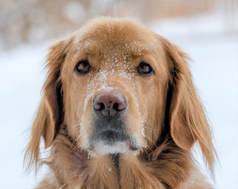Laurie Anne Walden, DVM  Cold weather can be hazardous to pets. Fur is not enough to protect pets when the temperature plummets, even if they spend most of their time outdoors when it's warmer. If it’s too cold for people to be outside for very long, it’s too cold for dogs and cats too. Some cities have regulations stating that animals cannot be left outdoors when the temperature falls below a certain point. Charlotte-Mecklenburg’s animal ordinance is more general: “Animals must have an adequate shelter so that the animal can be protected from extremes of weather (heat, cold, rain, etc.) and able to remain dry and comfortable.” Use common sense when deciding how long your pets can be outdoors in cold weather. Know your pets’ limitations Some pets are more tolerant of cold weather than others. Body condition, coat type, age, and health all affect an animal’s ability to withstand low temperatures. A healthy 3-year-old Siberian husky can handle the cold more easily than an arthritic 11-year-old greyhound, but even the husky is susceptible to hypothermia if left outside too long. Medical conditions like heart disease and thyroid disease can make it harder for pets to regulate their body temperature. Pets with arthritis may be more likely to fall if they encounter icy patches. Very young and very old animals can also have trouble managing temperature extremes. These pets can go outdoors in the cold, but their time outside should be supervised and shorter than usual. Watch for signs that your pet is having trouble with the cold:
Bring them indoors It’s fine to let healthy dogs play outdoors in the cold for a while, but they shouldn’t stay out for a long time. In weather as cold as we’ve had this past week, dogs should certainly be indoors at night. How long they can stay outside during the day depends on the dog and the environment. The safest approach is to keep dogs indoors during the day and take them out frequently for supervised exercise. The Humane Society recommends never leaving cats outdoors in cold weather at all. Cats sometimes seek shelter in warm car engines. Bang on the hood of your car and perhaps honk the horn before you start the engine to evict stray cats and wildlife that might have taken refuge under the hood. Wrap them up We’ve seen some spiffy coats and sweaters on dogs coming into the clinic. If you think your pet will be more comfortable in a coat, be sure it fits snugly and has no loose parts that might trap legs or become a chew hazard. Remove wet clothing immediately; it will make pets colder. Keep them safe on walks January is Walk Your Pet Month. Even in cold weather, walking has great health benefits for both you and your dog. Keep dogs on a leash when you’re near bodies of water so they won’t jump in. Wipe their paws when you come indoors to remove ice balls stuck between their paw pads and chemicals used to melt ice on roads. Avoid poisons Ice-melting chemicals and salt are dangerous if swallowed or licked off paws. Keep these products out of reach of your pets. Do not let your pets lick or walk through any liquid that has leaked from a motor vehicle. Even small amounts of antifreeze can be deadly; windshield washing solution is also toxic. More tips: Cold weather pet safety (AVMA) Cold weather safety tips (ASPCA) 7 Tips to keep animals healthy during cold weather (NCSU) Photo by Marcus Löfvenberg Comments are closed.
|
AuthorLaurie Anne Walden, DVM Categories
All
Archives
June 2024
The contents of this blog are for information only and should not substitute for advice from a veterinarian who has examined the animal. All blog content is copyrighted by Mallard Creek Animal Hospital and may not be copied, reproduced, transmitted, or distributed without permission.
|
- Home
- About
- Our Services
- Our Team
-
Client Education Center
- AKC: Spaying and Neutering your Puppy
- Animal Poison Control
- ASPCA Poisonous Plants
- AVMA: Spaying and Neutering your pet
- Biting Puppies
- Boarding Your Dog
- Caring for the Senior Cat
- Cats and Claws
- FDA warning - Bone treats
- Force Free Alliance of Charlotte Trainers
- Getting your Cat to the Vet - AAFP
- Holiday Hazards
- How To Feed Cats for Good Health
- How to Get the Most Out of your Annual Exam
- Indoor Cat Initiative - OSU
- Introducing Your Dog to Your Baby
- Moving Your Cat to a New Home
- Muzzle Training
- Osteoarthritis Checklist for Cats
- What To Do When You Find a Stray
- Our Online Store
- Dr. Walden's Blog
- Client Center
- Contact
- Cat Enrichment Month 2024
|
Office Hours
Monday through Friday 7:30 am to 6:00 pm
|
Mallard Creek Animal Hospital
2110 Ben Craig Dr. Suite 100
|
Site powered by Weebly. Managed by IDEXX Laboratories

 RSS Feed
RSS Feed